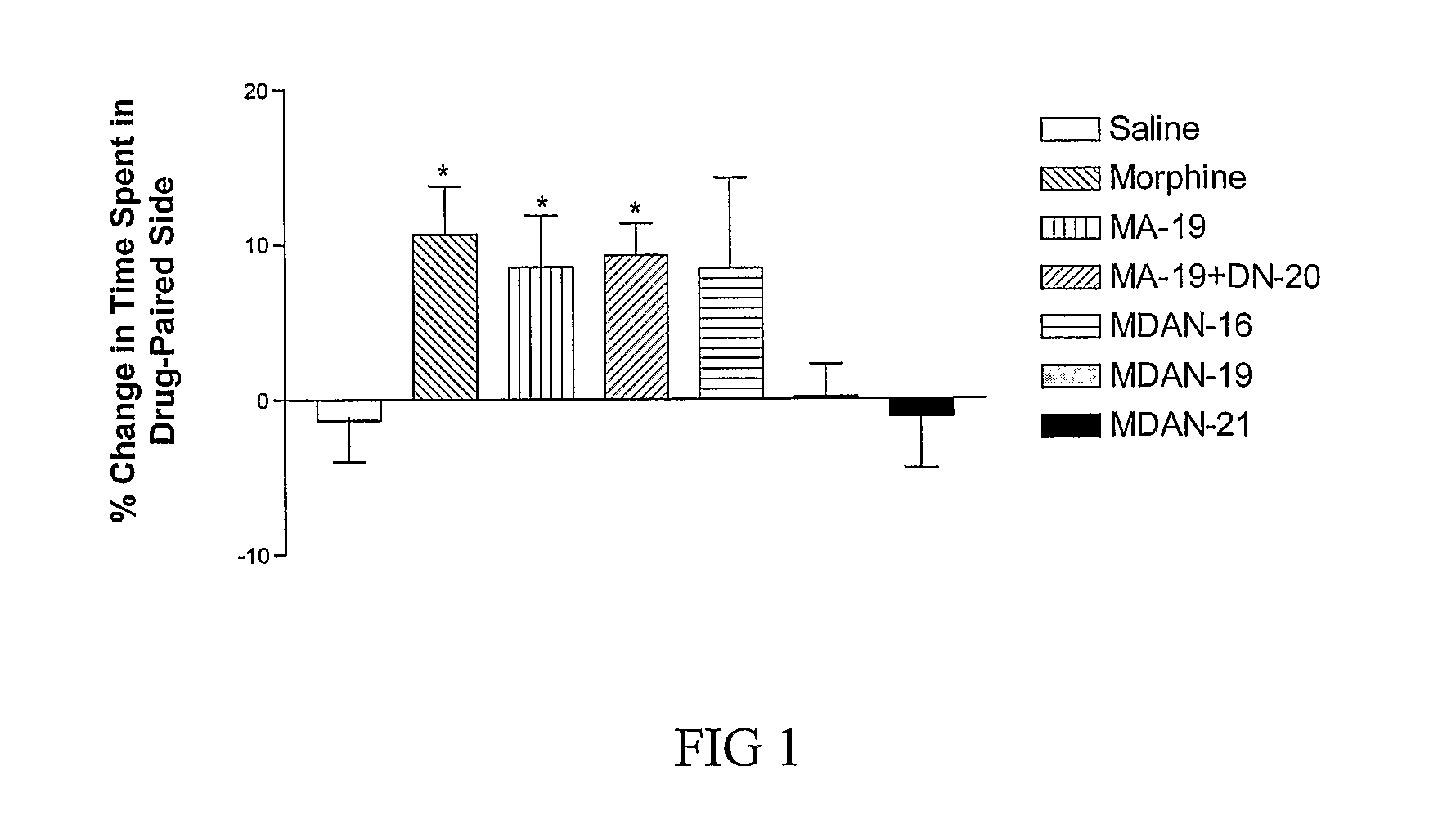Analgesic conjugates
a technology of conjugates and analgesics, applied in the field of analgesic conjugates, can solve the problems of limited administration of these drugs, major health and economic problems, and pain, and achieve the effects of less tolerance, physical dependence, and constipation
- Summary
- Abstract
- Description
- Claims
- Application Information
AI Technical Summary
Benefits of technology
Problems solved by technology
Method used
Image
Examples
example 1
Analgesia with Reduced Tolerance and Dependence
[0119]A series of conjugates containing a mu opioid receptor agonist and a delta opioid receptor antagonist were designed, synthesized and evaluated by chronic ICV administration. The shortest compound produced both tolerance and dependence with chronic ICV administration that was similar to both morphine and a control ligand. However, when the distance between the two pharmacophores of the conjugate exceeded 16 atoms, the conjugate no longer produced tolerance or dependence.
[0120]Acute studies. For the MDAN series, increasing the linker length led to increased acute antinociceptive potency (ICV). As this profile was not observed for members of the mu control series (MA-16, MA-17, MA-18, MA-19, MA-20, MA-21; see Table 1), suggesting that another factor, such as bridging dimeric mu-delta opioid receptors, may be responsible. The observation that the conjugates were less potent than their control counterparts not having both a mu agonist ...
example 2
Analgesia without Inhibition of GI Transit
[0148]One unwanted side effect of treatment with opioids is constipation caused by opioid-induced inhibition of GI transit. Surprisingly, conjugates typically produced less GI transit inhibition than does morphine.
[0149]Methods Drugs were administered IV via the tail vein in a volume of 100 μl to male ICR mice. Fifteen minutes later, antinociception was measured by the tail flick assay and charcoal meal (300 μl, oral) was administered by gavage. Thirty minutes after the charcoal meal., the mice were sacrificed by halothane overdose and the distance the charcoal traveled relative to the entire length of the GI tract was compared to the distance traveled in control animals injected with saline. The conjugates tested (MDAN-16, MDAN-19, MDAN-20, and MDAN-21) had linker lengths of 19, 23, 24, and 25 Å.
[0150]Results Morphine was fully efficacious in both the TF test and GIT inhibition assay with similar ED50 values (168 (146-178) and 129 (115-142)...
example 3
Conditioned Place Preference
[0152]Conditioned place preference (CPP) is a technique used to measure the rewarding properties of a drug. Two sides of the CPP apparatus have both visual and tactile differences, so that a mouse can tell the difference between sides. On the first day of testing, the time each mouse spends in either side of the apparatus is measured. For the next three days, the drug is “paired” with one side or the other by injecting the mouse and immediately confining it to that side. On the final day, the amount of time the mouse spends in the drug-paired side is determined and the percent change is calculated. If the percent change is positive, the drug is thought to be rewarding and likely to be abused by humans.
[0153]Mice were initially conditioned with morphine at 2× the ED90 analgesic dose, which resulted in the mice exhibiting a conditioned place preference. (FIG. 1) Mice also demonstrated conditioned place preference when treated with 4× the ED90 analgesic dose...
PUM
| Property | Measurement | Unit |
|---|---|---|
| Length | aaaaa | aaaaa |
| Composition | aaaaa | aaaaa |
| Therapeutic | aaaaa | aaaaa |
Abstract
Description
Claims
Application Information
 Login to View More
Login to View More - R&D
- Intellectual Property
- Life Sciences
- Materials
- Tech Scout
- Unparalleled Data Quality
- Higher Quality Content
- 60% Fewer Hallucinations
Browse by: Latest US Patents, China's latest patents, Technical Efficacy Thesaurus, Application Domain, Technology Topic, Popular Technical Reports.
© 2025 PatSnap. All rights reserved.Legal|Privacy policy|Modern Slavery Act Transparency Statement|Sitemap|About US| Contact US: help@patsnap.com



